Seasonal variation in bay‐marsh sediment exchange through a back‐barrier salt marsh tidal creek
IF 3.7
1区 地球科学
Q1 LIMNOLOGY
引用次数: 0
Abstract
Salt marsh resilience to sea‐level rise largely depends on the balance of sediment exchanges with surrounding bays. In this study, we investigate mechanisms that determine residual sediment fluxes using continuous measurements of bay‐marsh sediment exchange conducted in a tidal creek spanning 13 months (753 tidal cycles) in an intertidal marsh recently subsidized with sediment via thin‐layer placement. The maximum water level in each tidal cycle varied over seasonal and fortnightly timescales and was driven by a combination of the seasonal cycle in mean sea level (maximum in September, minimum in January) and the fortnightly spring‐neap cycle. Residual water fluxes tended to be ebb‐directed during overbank tides, possibly due to water crossing creekshed boundaries in the intertidal zone when water levels were sufficiently high. Sediment concentrations on the ebb of overbank tides exceeded those of their corresponding floods, but only for tidal cycles in which water temperatures exceeded 14°C. The interaction of these dynamics resulted in over 90% of the net sediment export from the creek occurring during overbank tides during warmer months—conditions met in 30% of the observed tidal cycles. These findings exemplify the importance of accounting for seasonality in sediment fluxes when assessing sediment budgets of salt marshes and illustrate how sediment budgets assessed with shorter duration datasets may exhibit seasonal bias. Additionally, they suggest that sediment retention for thin‐layer sediment placement projects may be high over the course of the first year after sediment subsidies are deployed.通过后屏障盐沼潮汐溪的海湾-沼泽沉积物交换的季节变化
盐沼对海平面上升的恢复能力在很大程度上取决于与周围海湾的沉积物交换平衡。在这项研究中,我们通过连续测量海湾-沼泽沉积物交换来研究确定剩余沉积物通量的机制,这些交换是在一个潮间带沼泽的潮汐溪中进行的,该潮汐溪跨越13个月(753个潮汐周期),最近通过薄层放置的方式获得了沉积物。每个潮汐周期的最高水位在季节和两周的时间尺度上变化,并由平均海平面的季节周期(9月最高,1月最低)和两周的春季-小潮周期共同驱动。在过岸潮期间,残留的水通量趋向于退潮方向,这可能是由于当水位足够高时,水在潮间带越过小溪边界。但只有在水温超过14°C的潮汐循环中,潮退时的沉积物浓度高于相应的洪水时的沉积物浓度。这些动力的相互作用导致超过90%的净泥沙输出发生在温暖月份的岸潮期间,这种情况在观测到的潮汐周期中占30%。这些发现说明了在评估盐沼沉积物收支时考虑沉积物通量季节性的重要性,并说明了使用较短持续时间数据集评估的沉积物收支如何可能表现出季节性偏差。此外,他们认为,在沉积物补贴部署后的第一年,薄层沉积物安置项目的沉积物保留率可能很高。
本文章由计算机程序翻译,如有差异,请以英文原文为准。
求助全文
约1分钟内获得全文
求助全文
来源期刊

Limnology and Oceanography
地学-海洋学
CiteScore
8.80
自引率
6.70%
发文量
254
审稿时长
3 months
期刊介绍:
Limnology and Oceanography (L&O; print ISSN 0024-3590, online ISSN 1939-5590) publishes original articles, including scholarly reviews, about all aspects of limnology and oceanography. The journal''s unifying theme is the understanding of aquatic systems. Submissions are judged on the originality of their data, interpretations, and ideas, and on the degree to which they can be generalized beyond the particular aquatic system examined. Laboratory and modeling studies must demonstrate relevance to field environments; typically this means that they are bolstered by substantial "real-world" data. Few purely theoretical or purely empirical papers are accepted for review.
 求助内容:
求助内容: 应助结果提醒方式:
应助结果提醒方式:


